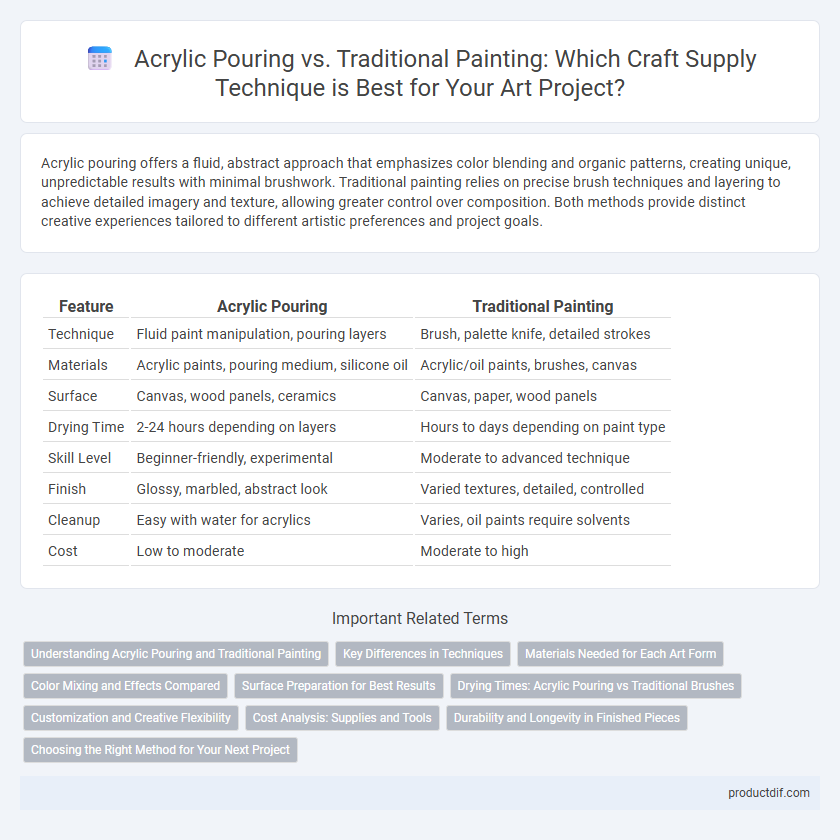Acrylic pouring offers a fluid, abstract approach that emphasizes color blending and organic patterns, creating unique, unpredictable results with minimal brushwork. Traditional painting relies on precise brush techniques and layering to achieve detailed imagery and texture, allowing greater control over composition. Both methods provide distinct creative experiences tailored to different artistic preferences and project goals.
Table of Comparison
| Feature | Acrylic Pouring | Traditional Painting |
|---|---|---|
| Technique | Fluid paint manipulation, pouring layers | Brush, palette knife, detailed strokes |
| Materials | Acrylic paints, pouring medium, silicone oil | Acrylic/oil paints, brushes, canvas |
| Surface | Canvas, wood panels, ceramics | Canvas, paper, wood panels |
| Drying Time | 2-24 hours depending on layers | Hours to days depending on paint type |
| Skill Level | Beginner-friendly, experimental | Moderate to advanced technique |
| Finish | Glossy, marbled, abstract look | Varied textures, detailed, controlled |
| Cleanup | Easy with water for acrylics | Varies, oil paints require solvents |
| Cost | Low to moderate | Moderate to high |
Understanding Acrylic Pouring and Traditional Painting
Acrylic pouring involves fluid acrylic paints mixed with pouring mediums to create free-flowing, abstract designs, emphasizing spontaneity and vibrant color blending. Traditional painting typically uses brushes and techniques on surfaces like canvas, focusing on controlled strokes and detailed imagery with acrylics, oils, or watercolors. Understanding these methods highlights the contrast between acrylic pouring's unpredictability and traditional painting's precision in craft supply applications.
Key Differences in Techniques
Acrylic pouring involves mixing acrylic paint with a pouring medium to achieve fluid, abstract patterns by tilting and manipulating the canvas, while traditional painting uses brushes to apply paint in controlled strokes for detailed imagery. The pouring technique emphasizes spontaneity and blending of colors with minimal tool interaction, whereas traditional painting requires precision and layering to build depth and texture. Acrylic pouring often results in glossy, unpredictable finishes, contrasting with the textured, more controlled surface outcomes typical of traditional paint applications.
Materials Needed for Each Art Form
Acrylic pouring requires fluid acrylic paints, pouring medium, silicone oil for cells, and surface protectors like cups and plastic sheets to manage the liquid consistency. Traditional painting relies on thicker paints such as oil or acrylic tubes, brushes of various shapes and sizes, palettes for mixing, and canvas or paper designed for the paint type. Both techniques demand specific materials tailored to their unique application methods and desired effects.
Color Mixing and Effects Compared
Acrylic pouring offers dynamic color mixing with fluid layers that naturally blend and create unique marbled effects, unlike traditional painting where colors are manually mixed on a palette for controlled application. The flowing nature of acrylic pouring results in organic, unpredictable patterns and cells formed by additives like silicone, enhancing texture and depth. Traditional painting techniques allow precise color gradients and detailed brushwork, while acrylic pouring emphasizes spontaneous color interaction and abstract compositions.
Surface Preparation for Best Results
Acrylic pouring requires a smooth, sealed surface free of dust and grease to ensure even paint distribution and prevent absorption, often achieved by priming with a glossy acrylic medium or pouring on sealed wood, canvas, or glass. Traditional painting often demands a textured surface like gesso-primed canvas to help acrylic or oil paints adhere effectively while allowing layers to build. Proper surface preparation for each technique enhances paint adhesion, drying times, and durability, directly impacting the overall finish and longevity of the artwork.
Drying Times: Acrylic Pouring vs Traditional Brushes
Acrylic pouring dries significantly faster than traditional brush painting due to its fluid consistency, often setting within hours compared to the days required by thicker brush-applied layers. The drying speed of acrylic pouring depends on factors like humidity, pouring medium, and layer thickness, typically ranging from 4 to 12 hours. Traditional painting with brushes involves multiple drying stages, as each brushstroke layer demands ample time to cure to prevent cracking or smudging, extending the overall drying time to 24-72 hours or more.
Customization and Creative Flexibility
Acrylic pouring enables unparalleled customization through fluid dynamics, allowing artists to create unique, swirling patterns and textures that are difficult to replicate with traditional painting methods. Traditional painting offers precise control over brushstrokes, color layering, and fine details, providing versatility for intricate designs and realistic imagery. Both techniques deliver creative flexibility, but acrylic pouring excels in abstract expression while traditional painting supports detailed, controlled artistry.
Cost Analysis: Supplies and Tools
Acrylic pouring requires fewer specialized tools such as silicone oils, pouring mediums, and disposable cups, which often results in lower initial costs compared to traditional painting that demands a wide range of brushes, canvases, and multiple paint types like oils or acrylics. Traditional painting supplies tend to be more expensive due to the need for high-quality brushes, palettes, and canvases, as well as potentially costly oil paints and solvents. Acrylic pouring's consumable items are generally more affordable and accessible, making it a budget-friendly option for beginners and hobbyists seeking vibrant results with minimal investment.
Durability and Longevity in Finished Pieces
Acrylic pouring creates a durable, glossy finish that resists cracking and fading over time, making it ideal for pieces exposed to varying environmental conditions. Traditional painting techniques, while offering rich texture and depth, may require protective varnishes to enhance longevity and prevent deterioration. The inherent flexibility of acrylic pouring mediums ensures sustained vibrancy, whereas traditional oils and acrylics depend heavily on the artist's sealing methods for long-term preservation.
Choosing the Right Method for Your Next Project
Acrylic pouring offers vibrant, fluid designs ideal for abstract and dynamic compositions, making it perfect for projects seeking spontaneity and bold color blending. Traditional painting provides greater control over detail and layering, suitable for realistic or structured artwork requiring precision. Selecting between acrylic pouring and traditional painting depends on the desired aesthetic, project complexity, and personal technique preferences.
Acrylic pouring vs Traditional painting Infographic

 productdif.com
productdif.com